1) THE PRESIDENT'S CORNER (by Tom Steichen)
 Still
wearing my mask... hope you are too! Still
wearing my mask... hope you are too!
If you are observant, you may recall that my mask last month was black and white (I thought it went well with my
black shirt!)... but then Bob Chapman wrote, "You look good in New York Yankees pinstripes!" My reply was, "Oy! I
knew there was something disturbingly familiar about that pattern... said by a Minnesota Twins fan who has had his viral
baseball fever snuffed out by pinstripes way too often! ;~)." So I was "forced" to change the color (and I went with a
Vikings' theme to further distance from the Yankee vibe!). Things we Minnesotans have to do!
This month's bits and pieces (Article 1) has a request for help, a report on some
new parishes at Matriken.at, a comment about a new Catholic deanery in Trausdorf, a story about
the new timber loading station in Rotenturm and a (lengthy) note about Sankoháza and the family
it is named after.
We also include our regular tidbit features, the monthly BB Facebook report, book sales and a humor item.
Article 2 tells A Post-WW-II Emigration Story. I became interested in this story because I was
not aware that it was possible to emigrate from Soviet-occupied Burgenland in 1954. I talked with the emigrant involved and
learned much from her words and the research I did to understand better; I hope you learn something too.
The remaining articles are our standard sections: Historical Newsletter Articles, (no) Ethnic Events
and Emigrant Obituaries.

A Burgenland Descendant Needs Help: BB member Sarah Kierein wrote me this month with the kind of request I try
to avoid. Why? Because it was a request with only an extremely peripheral relationship to the core ideas of
Burgenland genealogy and history that the BB was set up to share. I hope you have noticed that both this newsletter and the
BB website have remained free of commercial links and offers... their absence is absolutely by design. And while Sarah's
request is not of the commercial type (which would have been rejected immediately), it does involve a request for donations
of both a highly personal and of a financial nature. Let me explain...
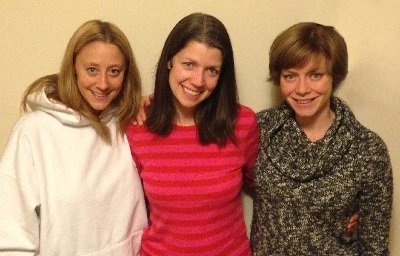 Sarah's
younger sister Molly is in end stage renal failure and needs a new kidney; coping with this is also putting her in
financial distress. So Sarah is trying to do all she can to help Molly survive, even to the point of asking the BB community
for whatever help you can give. Why us? Because Molly is the youngest great-grandchild of John Kierein and Katherine
Ganzer from Pamhagen, Burgenland (they emigrated to South Bend, IN). So Molly is one of us. Sarah's
younger sister Molly is in end stage renal failure and needs a new kidney; coping with this is also putting her in
financial distress. So Sarah is trying to do all she can to help Molly survive, even to the point of asking the BB community
for whatever help you can give. Why us? Because Molly is the youngest great-grandchild of John Kierein and Katherine
Ganzer from Pamhagen, Burgenland (they emigrated to South Bend, IN). So Molly is one of us.
You may know that kidneys are in very short supply, forcing those in need of one to find their own living donor or remain at
the tail end of a very long list for a deceased donor kidney. I, myself, am very aware of this because I had a
younger sister who was severely diabetic, was on dialysis, and eventually died of diabetic complications. She was on a
donor-request list but never found a donor that matched her well enough. (To be honest, this is my personal reason for going
beyond the normal bounds of this newsletter and helping Sarah and Molly with this message.)
While we all are born with two kidneys and can survive quite well with one, it takes a very special person to give one up. I
don't know if I could do that but maybe you can. Anyway, there is a website that has been set up for Molly that explains all
this better than I can: savemollyslife.org. It will tell you about being a potential
kidney donor.
There is also a GoFundMe site here: gf.me/u/yf9fau set up to accept financial
donations. I understand this need too, as my sister's health quickly deteriorated to the point she could no longer work.
As Sarah wrote: "I know this is a big ask, but I'm hoping you could include something about this in the next Burgenland
Bunch Newsletter. The more people who see it, the higher the likelihood of getting her a kidney and a little financial
support."
So decide for yourself whether you can help, even if it is with just a few dollars. But if knowing that you can save a life
is important to you, look into the kidney donation process too.
The websites above will provide the key information, but Sarah is also willing to talk with you via email (sarahkierein@gmail.com),
if that works better for you.
Regardless you have my thanks for at least considering what you can do and, I'm sure, Sarah and Molly's too.

Editor: as I noted above, this tidbit is out of character for the BB Newsletter. I am concerned that you may
be discomforted by such a message so I want to know your feelings.
Should I totally prohibit messages like this?
Or, are you OK with a rare request for help for someone in our BB community?
In this case, it is a life-threatening illness and one dear to my heart (though my personal interest should not be a
deciding factor). I do know that if I'm overwhelmed with requests for help, I will shut them all down (as I do not want to
overwhelm you), and I certainly will not consider anything that is not life-threatening. But, dear readers, this is your
newsletter too, so I request, and will seriously take into consideration, your feeling on the topic.

New Parishes Online at Matriken.at: BB staff member Patrick Kovacs reported that images for records
from the parishes of Frauenkirchen, Halbturn, Mannersdorf, Mattersburg and Neckenmarkt are now online at
Matriken.at.

New Bilingual Catholic Deanery in Trausdorf: The Catholic Diocese of Eisenstadt recently made a couple of
changes in its administrative organization. The Eisenstadt Diocese is composed of 172 parishes in Burgenland divided among
twelve "Deaneries" (prior to 1973 there were 15 Deaneries). A Deanery is an ecclesiastical administrative units
within a diocese that manages a collection of parishes and their staffs.
The current changes affect the Church's organization in districts Eisenstadt and Mattersdorf. First, both Eisenstadt and
Rust previously had independent Deaneries, and they have been merged. Then a new Deanery was established in Trausdorf with
the distinction that it will be a Croatian/German bilingual Deanery serving a group of parishes that all have a substantial
Croatian membership. The parishes are: Antau, Baumgarten, Draßburg, Hornstein, Klingenbach, Oslip, Siegendorf, Steinbrunn,
Trausdorf, Wulkaprodersdorf, Zagersdorf, Zillingtal (with Baumgarten and Draßburg being from the northern edge of district
Mattersdorf).
It is not clear to me whether the two prior Deaneries, Eisenstadt and Rust, managed parishes beyond their city borders. As
free cities, both are politically independent Bezirks (civil administrative districts) separate from the wider
surrounding Eisenstadt Bezirk. However, there is no reason the Church would have needed to honor the civil distinctions (as
they obviously did not in establishing the Trausdorf Deanery).

Rotenturm Timber Loading Station Opened: ORF News ran a story in June about the move of a timber-loading rail
station from Oberwart to outside of Rotenturm, ten kilometers away. The new timber loading point is located in the area of
the former Rotenturm train station and directly off the B63, the major state road through the area. More importantly, it is
no longer in the urban area of Oberwart, where it caused trouble for residents and community officials, as the prior truck
access was through the downtown governmental, shopping and commercial district of Oberwart, and the loading point, which was
just a block behind the downtown district, created dust and noise pollution. Oberwart Mayor Georg Rosner said they had
repeatedly asked for this and are now happy and grateful that the loading point has been relocated.
Maintaining a loading point was of concern for the state of Burgenland because, with passenger traffic already lost,
securing continued freight traffic was essential to "not only to revitalize this economic region, but to develop it
further," according to Governor Doskozil. To make the move possible, the state of Burgenland bought the disused railway
line between Oberwart/Unterwart and Großpetersdorf in 2018, investing more than one million euros. More than 200 meters of
track were relocated for the new loading station and the approaches were provided with lighting and asphalted to accommodate
heavy vehicles.
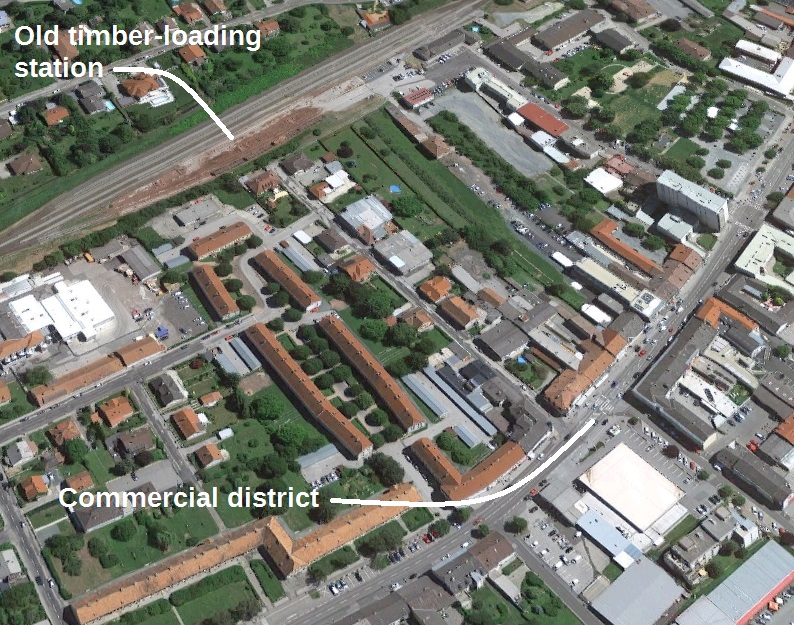
The main beneficiary of the new loading point is the city of Oberwart, where the timber was previously loaded. Rotenturm
itself is not burdened by the new timber loading station because it is located well outside of the village. Now large
amounts of round and sawn timber can be brought from the road to the rail, with about 32,000 tons currently schedules to be
loaded at the new timber loading station.

More on Sankoháza (in Güssing Gemeinde): BB member Bob Schatz and I had an email exchange concerning
the Sankoháza Mayerhof this past month that consisted of an initial information-filled message from Bob, a number of
back-and-forth exchanges where Bob helped me resolve some questions that arose as I tried to translate the German-language
text he had quoted, and then yet another long quote by Bob of a related German-language text from another source. Rather
than cite each email in the exchange, I will edit Bob's original message to incorporate answers to my questions. Bob writes:

Dear Tom, I hope all’s been well with you and yours.
Regarding the discussion of Sankoház in the recent newsletter, I also “had previously heard about this place”
(quoting you in the article), and had visited it in 2001. It is southwest of Urbersdorf and north of Glasing. It plays a
role in my 18th-century ancestry and my family's origins in Burgenland. Let me briefly explain that first, and then provide
what I know about Sankoház itself.
My earliest documented paternal ancestor in Burgenland is Johann Schatz, who married Margaretha Bastl of Tobai in 1719 in
Güssing. The baptismal records of their children born in 1719, 1726, 1730, 1732, and 1734 all state in Latin that the
parents were “ex Shankohas” - from Sankoház (I must credit my cousin Anna Gully of Strem here, she researched the
marriage and baptisms in the Güssing volumes in Eisenstadt back in the 1990s). My ancestor Johann was not originally from
the Güssing area. My many years of research have uncovered no Schatz in the church or civil records of Komitat
Eisenburg / Vas Megye before that 1719 marriage (genetics now suggest a possible origin in Vorderösterreich, but
that’s another story). I surmise that, as a young man newly arrived, Johann did not have the means to purchase a farm lease
from the Güssing Herrschaft, but instead found employment as a farmhand at Sankoház. Between 1734 and 1736 he did
apparently acquire a farm because he is “ex Urbersdorf” in the baptismal record of his son in 1736. The descendants
of that child, my paternal ancestors, lived and farmed in Urbersdorf until the 1920s (interestingly, this fact is mentioned
by Father Gratian Anton Leser in a 1929 article in the Güssinger Zeitung).
The origin of Sankoház goes back at least to the mid-16th century, when it was a dairy farm owned by the merchant Nicholas
Sanko, first mentioned as a trader of wheat and salt in Güssing in 1539 (more on him below). The farm passed to his heirs
but, upon the extinction of the family in 1691, it reverted to the Batthyány. Sankoház is now owned by the current Count
Draskovich (Schloss Draskovich is one mile west), it was included in the dowry of Elizabeth Batthyány when she
married Count Karl Draskovich in 1841.
Ed: This 1841 date was clearly incorrect as Sankoház was owned by Philipp Batthyány in the 1857 Parzellen
Protocolle; Bob later wrote:
Since sending my prior email, I have learned that Sankoház was not acquired by the Draskovich as dowry in 1841.
Elizabeth Batthyány, Countess Draskovich, was a niece of Prince Philipp Batthyány-Strattmann. He died unmarried and
childless in 1870. The title passed to a 2nd cousin, Gustav Batthyány but, in his will, Philipp left his estates and
property in Güssing and Punitz to Elizabeth. This included Sankoház. Elizabeth’s husband Karl had died in 1855, so their
sons eventually inherited these properties from their mother. Hence the Draskovich now own much of the former properties
of the Batthyány in and around Güssing.
Interestingly, Philipp’s will also established the foundation that maintains and preserves Burg Güssing. The main
residence of the princely family in modern times was at the palace in Körmend, until the Batthyány properties in Hungary
were expropriated after 1945.
But let us return to Bob's original message:
During a trip to Austria in 2001, I visited Sankoház with my cousins from Strem. We had a pleasant talk with the then
tenants of the main house, sitting out back along the Strembach. I suspect this is the house that is the number 153 you cite
from the cadastral map [Ed: actually, if along the Strembach, that would be #154]. I remember that the (empty)
living quarters for farmhands and their families were a long block of attached residences next to the house. The buildings
can be all be seen on Google Earth.
Regarding Nicholas Sanko, the following is quoted from: Floiger, Michael, et al., Geschichte des Burgenlandes, Lehrbuch
für die Oberstufe (Wien: Hölzel 1996), page 99.
[Ed: the quoted text was in German; I have translated it here]:
“Nikolaus Sanko was part of a family from Ofen [Ed: Ofen = the Buda part of Budapest], which came from
Ragusa (Dubrovnik). Sanko had extensive business relationships with Venice, but he also did business with Turkey.
"Sanko raised a huge amount of capital via nobles who invested in his businesses. So he worked with Franz Batthyány, the
Ban of Croatia, who invested 20,000 guilders in Sanko's extensive trade. But Franz Batthyány was soon deeply indebted to
the wholesale merchant. To pay, he had to mortgage the village Sulz from his Güssing Herrschaft.
"Sanko owned a free house in Güssing. Nearby he ran a dairy farm, which later became the "Sankohaz-major" and
became the property of Batthyány (now owned by Draskovich).
"The reason why the wealthy Ragusan merchant settled in Güssing is to enter into, on the one hand, the Alpine trade of the
Habsburg Empire and, on the other hand, the freedom the citizens of Güssing had from the Dreissigst [Ed: a
'one-thirtieth' customs tariff on the import of products from the German, Galician and Lombardy-Venetian countries to
Hungary and Transylvania]. Franz Batthyány, the landlord of Güssing, had succeeded in gaining a liberation from the
Dreissigst after the Turkish wars of 1529 and 1532.
"However, the Ragusan wholesalers, as a whole, were unable to gain a foothold in the regions dominated by the Habsburgs
and concentrated their trading activities on the majority of the country, which was occupied by the Turks.
"The descendants of Nikolaus Sanko were based in Güssing. However, soon we will no longer find them as risk-taking
traders, but as civil servants and soldiers serving Batthyány."
With my very best regards,
Bob Schatz, New York, NY

Bob later sent a longer quote about Sankoháza and the Sanko family. As you will see, it was written by Father Gratian
Anton Leser, O.F.M. (1873-1949), a member of the Franciscan community at the cloister in Güssing and its Father Superior for
many years. Father Leser had an interest in southern Burgenland and translated (into German) much pertinent material about
it from the original Latin and Hungarian sources. His translations and articles found their way into the local newspapers in
the 1920s and 30s, as well as into scholarly publications.
Bob sent me Leser's German text and I translated it, so any errors in translation are my fault. However, I will note
that Bob detected two date errors in the original text, and I have applied his corrections to my translation. I'll also note
that this text is likely the source of the incorrect claim that the Draskovich acquired Sankoháza as dowry in 1841.
Leser writes that "...welcher endlich durch Heirat des Grafen Paul Draskovich und der Gräfin Elisabeth Batthyány 1831 in
den Besitz des ersten überging" (= "which finally came into the possession of the first (i.e., the husband) through
the marriage of Count Paul Draskovich and Countess Elisabeth Batthyány in 1841.")
While it is correct that Sankoháza came to the Draskovich family through (i.e., "as a result") of the marriage, Paul
Draskovich was the son of Elisabeth, not her husband (who was Karl). Karl was already dead when Elisabeth inherited
Sankoháza in 1870. So the real transfer to the Draskovich only occurred when Karl's son, Paul, inherited Sankoháza at his
mother's death in 1882. I have added these editorial corrections to my translation also.
Bob writes:

This [German text] is from a series on notable people from the Güssing area written by Father Leser that
appeared in the Güssinger Zeitung. This one is from 28 July 1928:
"There is a dairy farm near the municipality of Glasing in the Güssing area, which is known in various old writings and
is still popular today under the name Sankóház. In this Meierhof there is an ancient residential building on
the banks of the Strembach, today inhabited by Emerich Bogner, the estate manager for Count Draskovich. In the 16th
and 17th centuries, this building was an Edelhof [noble house] and was used by the Sanko family.
"Some writers give this family the nickname of Sankoház and want to move their origin to the southern Slavic port town of
Ragusa. Their first known family member was Johann Sanko, commander of the Hungarian fortress Késmárk in 1529.
"In a document from 1539, the nobleman Nikolaus Sanko is called "Familiaris" [friend and advisor], the
confidante of Franz Batthyány, and because the document speaks of our region, he was the first resident of the noble house
named after him. He will have received this noble court with the belonging for his heroic deeds with the Batthyány
soldiers in the Turkish wars, which can also be concluded from several similar gifts by the Batthyány. The Sanko family
seems to have been resident here since the first half of the 16th century, because their individual members are often
mentioned in the Güssing community protocol, which started in 1612. In 1625, Frau von Sanko complained to the city court
via Peter Blasko about three fields above the cemetery.
"At the time of the great division of belief in the 16th century, this family joined the Helvetian [Swiss/Calvinist]
creed, which is confirmed by the fact that on November 13, 1633, in Sankoház, when Peter Balogh married the daughter of
the nobleman Sanko, the Swiss superintendent Johannes Paulides Canisacus gave a speech about the gospel of the
false prophets, targeting the young lord and count, Adam Batthyány, who had returned to the Catholic Church three years
previously, and [Batthyány was] so angry with him that on November 24 of that year he expelled the superintendent, and on
February 9, 1634, by decree expelled all evangelical and reformed clergymen and teachers from his estates.
"This decree did not affect the Sanko family, who could remain in their belief, as evidenced by the fact that the
Predicant of Lábad, Michael Fidel and his wife mortgaged their property in Táplánfa in 1644 to the nobleman Balthasar
Sanko until the sum of 120 thalers was repaid. Later we find this family again in the lap of the Catholic Church
as, in 1671, 1682 and 1688, Balthasar Sanko appeared as godfather in the local baptismal register, and in Güssing in the
Roman Catholic rite are baptized in 1690, Katharina, the child of Nikolaus Sanko and his wife Katharina, and in
1709, Franz Johann, the son of Georg Sanko and Maria Vinkelmarin.
"After pointing out their belief, we want to follow the story of Sanko further. We know from a trial in 1638 that this
family owned 33 immovable properties in Somogy and Zala counties, that Balthasar Sanko was leader of a imperial Hussar
division at the Kiskomárom border fortress, and that the late Kaspar Sanko had left the widow Margaretha Herant and two
sons Nikolaus and Stefan.
"The Kiskomárom border fortress was a very important and dangerous post in those Turkish wars. The Turks had conquered the
Gross-Kanizsa fortress in 1600 and strongly fortified it. In order to prevent their further advancement, a protective
fortress had to be built by Austria-Hungary near them in Kiskomárom. Here the Christians had countless battles with the
Turks until the reconquest of Kanizsa in 1690. Here the Batthyány were the generals, the Sanko the Hussar leaders,
and the Batthyány soldiers from our territories therefore the fighters. At this time the Hussar leader Balthasar
Sanko and the above-mentioned two brothers Nikolaus and Stefan Sanko were so distinguished that, in 1640, on behalf of the
Emperor Palatine Nikolaus Esterházy of Galántha, they were awarded all of Maroth's property, half of the property of
Szentkirály, Szentmihály and Hosszúfalu, the Pusztanyir dairy in Sümeg county [actualy, Sümeg is a district, in
Veszprém county] and the goods of Syl, Sanacz and Cher in Tolna county.
"In a document dated 1641, the Hussar leader Balthasar Sanko named the following possessions as his property: 33
possessions in the Sümeg county, 5 in Zala county and 3 in Tolna; and in our area he owned vineyards in Langzeil near
Güssing and in Sumettendorf and Heiligenbrunn, in Güssing, he owned a puszta called Domogg, a stone house, a noble farm
called Sankoház near Glasing, and an estate in Urbersdorf.
"In 1642, Balthasar and Nikolaus Sanko bought a house in Güssing. In 1643, the noblewoman Margaretha Herant, and Kaspar,
Balthasar and Nikolaus Sanko were mentioned in the Güssing community protocol. In 1645, Johann Eszterházy and Nikolaus
Pethö presented the two Sanko, Balthasar and Nikolaus, with goods in recognition of their merits. In 1646, Balthasar Sanko
bought a house in the inner city of Güssing, with the count's stables to the east, next to the Kaspar Franchich and Daniel
Jobbágyi residential buildings. In 1655, Franz Márfy, who lived in Veszprém, borrowed 100 gold guilders from
Balthasar Sanko, for which he mortgaged his goods in Somogy county to Sanko in pledge. In 1656, Nikolaus Pethö pledged his
goods in Tolna and Sümeg counties to his brother-in-law Nikolaus Sanko for 100 thalers. In 1657, Nikolaus Sanko was
mentioned in the Güssing community protocol as a high employee at the court of Count Adam Batthyány and was mentioned
again in 1689. In 1671, 1682 and 1688, Balthasar Sanko is listed as a godfather in the Güssing baptismal book; in 1690
Nikolaus Sanko is listed as the father of a daughter and in 1692 with the general and count Adam Batthyány as a godfather
at the baptism of a Turk; and in 1709, Georg Sanko appears as the father of a baptized child; thereafter the family
disappears from the history of Güssing and of their Edelhof. On July 11, 1749, a child from Sankoház named Josef
Eutkymius was baptized, his noble parents being Franz Somogyi and Christina, with godparents Euthymius Marchio de
Castiglioni and Elisabeth Talian, from which it follows that at this time the Edelhof Sankoház was inhabited and
perhaps owned by the Somogyi family. However, in 1753 the Batthyány rule had already taken via Sankoház 5 fl. 30 kr for
wine, consequently also owned the Edelhof; which finally came into the possession of Count Paul Draskovich [in
1882] through his [father's] marriage with Countess Elisabeth Batthyány in 1841."

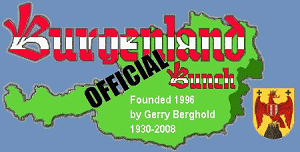 The
Facebook Bunch (from Vanessa Sandhu): The
Facebook Bunch (from Vanessa Sandhu):
Greetings Burgenland Bunch!
I hope that everyone is doing well and staying healthy. This month, we welcomed 28 new members, bringing our
total member count up to 1368. Please join us if you haven’t already! We’d love to have you!
We had a nice recipe-sharing thread, which motivated me to make some delicious goulash for the first time in
months. I always make the Hungarian version, but this time I tried a new recipe for Austrian beef goulash (Rindsgulasch).
It was really good and I will definitely make it again. Here is the link if you’d like to give it a try!
https://www.lilvienna.com/authentic-austrian-beef-goulash/
Member Roland Schuller shared an English translation of his recipe Grenadiermarsch:
https://lookaside.fbsbx.com/file/grenadiermarsch
A few members reminisced about St. Anna Kirtag celebrations in years gone by. We also had a little chat about
popular soccer/football clubs in Burgenland. We did quite a few translations and look-ups as well.
BB staff member Patrick Kovacs shared an update on additional villages added this month at the matriken.at
website. Now available are the villages of Frauenkirchen, Halbturn, Mannersdorf, Mattersburg, and Neckenmarkt.
We round out the month with a gorgeous video shared with us by Land Burgenland. Enjoy this bird’s eye
view of the Siegendorf and Klingenbach area:
https://www.facebook.com/.../2508619242574695/
Stay safe and healthy!
Take care!
Vanessa

 Update
for book "The Burgenländer Emigration to America": Here is this month's update on purchases of the English issue of
the 3rd edition of Dr. Walter Dujmovits' book "Die Amerika-Wanderung Der Burgenländer." Update
for book "The Burgenländer Emigration to America": Here is this month's update on purchases of the English issue of
the 3rd edition of Dr. Walter Dujmovits' book "Die Amerika-Wanderung Der Burgenländer."
Current total sales are 1534 copies, as interested people purchased 3 more books during this past month. Sales are being
estimated because our print-on-demand printer, Lulu.com, is still updating their site and systems, thus the
complete sales history is currently unavailable (but is expected to return in July). However, sales during the current month
are listed.
As always, the book remains available for online purchase at a list price of $7.41
(which is the production charge for the book, as we purposely choose not to make a profit so we can avoid dealing
with the income tax consequences and so you can obtain the book at as low a cost as possible!), plus tax & shipping.
See the BB homepage for a link to the information / ordering page and for information
about current discounts (there is at least one discount on price or shipping available most of the time... if not, wait a
few days and there will be one!). Getting the book and reading it is another excellent way to pass the time in self-imposed
quarantine.

Burgenland Recipes: No recipe this month...

 Note:
We have updated the recipes sortable list with links directly to the recipes or food-related
articles published in our past newsletters. You can access the list by clicking our recipe box (to the right). Thanks to the
contributions of our members over the years, we have quite a collection of Burgenland recipes, some with several variations. Note:
We have updated the recipes sortable list with links directly to the recipes or food-related
articles published in our past newsletters. You can access the list by clicking our recipe box (to the right). Thanks to the
contributions of our members over the years, we have quite a collection of Burgenland recipes, some with several variations.
However, we have now used up most of our unpublished recipes... thus this recipe section will become dormant when we run
out. So, if you have a favorite family recipe, please consider sharing it with us. We will be happy to publish it. Our older
relatives, sadly, aren't with us forever, so don't allow your favorite ethnic dish to be lost to future generations.
You can send your recipe to BB Recipes Editor,
Alan Varga. Thanks!

Cartoon of the Month:

|
2) A POST-WW-II EMIGRATION STORY
I became aware of Mitzi (Maria) Kaufmann when her daughter, Annie, wrote to ask if I would include the obituary of
Joseph Franz Kaufmann, Mitzi's son and Annie's brother, in the BB Newsletter's Burgenland Emigrant Obituaries
section. Joseph was born in 1950 in Strem, Burgenland, and died in March 2020, in Tuckerton, NJ, in his 69th year. As Joseph
clearly fit the parameters for inclusion in this section, I was agreeable and the obit was run in the April newsletter.
However, there was one line in that obituary that caught my attention:
"In November 1954, at the age of 4, Joseph immigrated to Toronto, Canada, and continued on to New Jersey in 1963."
I was fairly certain that the Soviet post-WW-II occupation of Burgenland did not end until 1955, so I was surprised that
his family was able to emigrate in 1954. In a return email, I asked Annie about this, saying:
"I’d be interested in hearing more about your family’s emigration from Burgenland. My understanding was that the
Soviet occupation did not end until May 1955, yet you report Joe (and presumably the whole family then) emigrating in
November 1954. I was not aware that was possible at that time so would appreciate enlightenment. It could be an
interesting and informative story for the newsletter. Please, when the time is right, consider what you can share on this
topic."
Annie wrote back to say that her mother, Mitzi (Maria), would be very happy to speak to me regarding their emigration,
that "...it would actually make her very happy to reminisce, so please feel free to contact her." I would later learn
that Annie was born well after her family's emigration, even after the move to New Jersey, so could not provide first-hand
memories of this event.
Thus, after I prepared a list of questions, I called Mitzi, now living with her daughter Rosemary, and had a forty-five
minute conversation with her... which I'll recount in the paragraphs below.

I began the interview by asking questions about Mitzi herself, her husband and their parents.
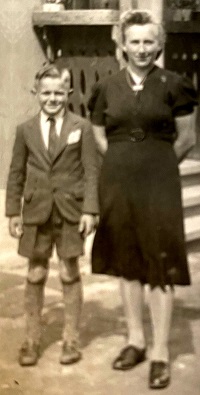 Maria/Mitzi
(Domitrovits) Kaufmann was born in Strem in 1927 (making her 92 now) to parents Franz and Theresia (Hafner)
Domitrovits, originally of Strem and Glasing, respectively. Despite the Croatian roots of her father's surname, they
spoke German in the home. Her father had been in Pittsburgh in 1922-1925, came back to marry Theresia and, by the time Mitzi
was born, had already gone back to America. By 1929, her mother joined her father in America, but in Saddle River, NJ. Mitzi
says she was raised by her grandparents, presumably Ignatz and Cecelia (Garger) Domitrovits on the family farm in Strem, as
mother-in-law Cecelia is listed as Theresia's contact at home on her 1929 manifest and Mitzi says she was raised in Strem.
She also says she seldom saw her parents (they appear in the 1930 US census living in Manhattan, NY, but I can't find them
in the 1940 census). Mitzi had one brother, Johann, born in Strem in 1937, died there in 1992 (he married and had one
daughter, who also married and gave him a grandson). Maria/Mitzi
(Domitrovits) Kaufmann was born in Strem in 1927 (making her 92 now) to parents Franz and Theresia (Hafner)
Domitrovits, originally of Strem and Glasing, respectively. Despite the Croatian roots of her father's surname, they
spoke German in the home. Her father had been in Pittsburgh in 1922-1925, came back to marry Theresia and, by the time Mitzi
was born, had already gone back to America. By 1929, her mother joined her father in America, but in Saddle River, NJ. Mitzi
says she was raised by her grandparents, presumably Ignatz and Cecelia (Garger) Domitrovits on the family farm in Strem, as
mother-in-law Cecelia is listed as Theresia's contact at home on her 1929 manifest and Mitzi says she was raised in Strem.
She also says she seldom saw her parents (they appear in the 1930 US census living in Manhattan, NY, but I can't find them
in the 1940 census). Mitzi had one brother, Johann, born in Strem in 1937, died there in 1992 (he married and had one
daughter, who also married and gave him a grandson).
Her husband was Franz Kaufmann, born 1924 in Strem to parents Josef Kaufmann and Theresia Karner,
originally of Fischa, Steiermark, and Strem respectively. His parents, too, went to America in 1929, heading to Nazareth,
PA; they would still be there in 1942 when Josef filled out his WW-II Draft Registration card (but I was unable to track
them further). Mitzi says Franz never knew his parents. Franz did have an older sister,
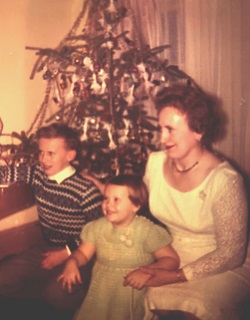 Hilda,
but I could not determine what happened with her. Hilda,
but I could not determine what happened with her.
Mitzi and Franz would marry in 1950, with the aforementioned son, Joseph Franz, soon following. The family would emigrate to
Toronto, Canada in 1954, where a daughter, Rosemary, would be born. In 1963, they would move on to New Jersey, where the
last daughter, Annie, would be born. Husband Franz, now known as Frank, died in New Jersey in 1997, at the age of 73.
But I'm jumping past the heart of this story... and the details that explain it.

To me, the heart of this story is why did the family emigrate when it did? ...and why was it allowed
to emigrate at that point in time? But for both of these questions, I will need to build a little background.
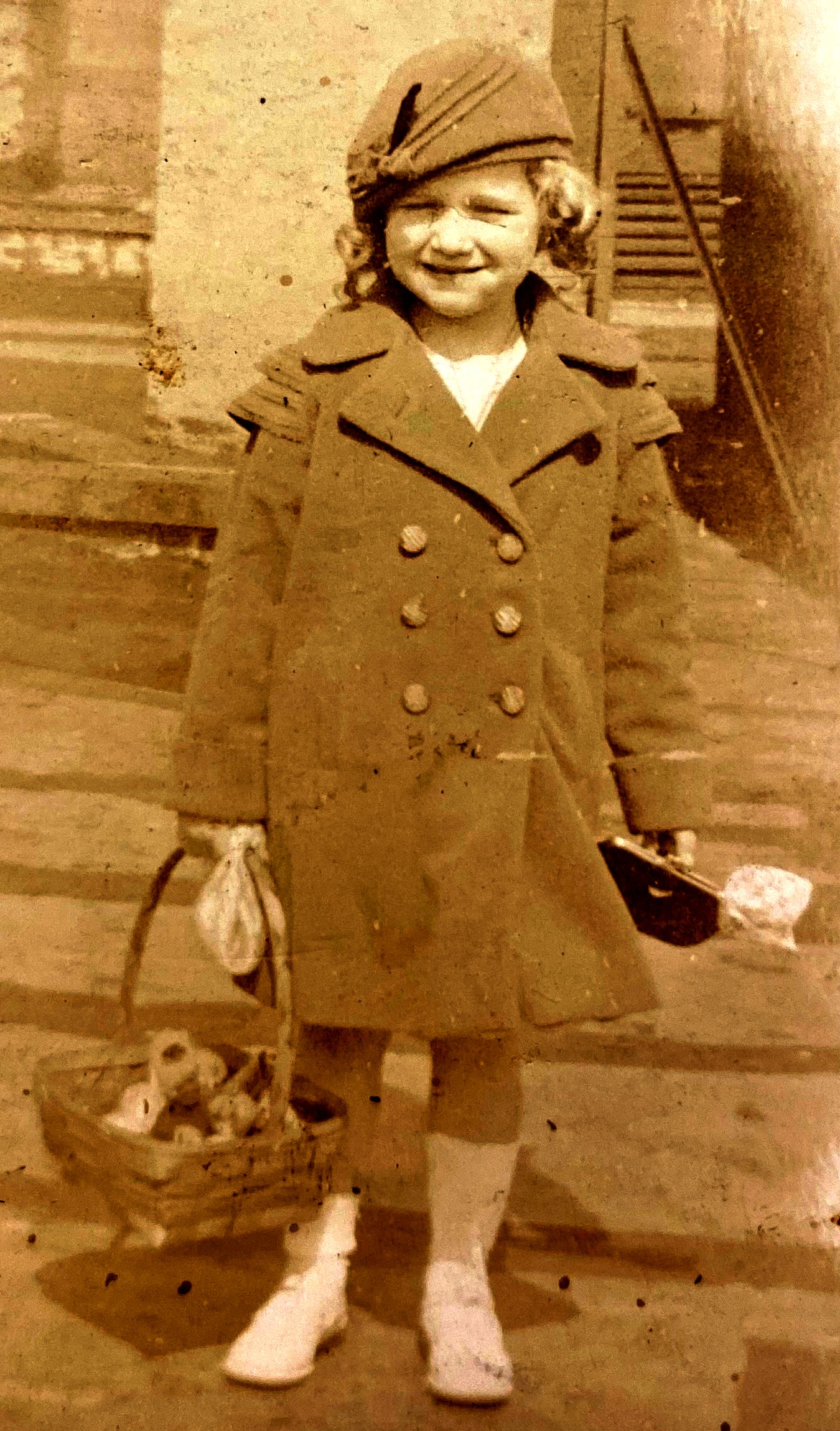 When
asked by me what her earliest memories of life in Burgenland were, Mitzi initially hesitated... then answered with just a
few words: "It was a good life; I miss it." When
asked by me what her earliest memories of life in Burgenland were, Mitzi initially hesitated... then answered with just a
few words: "It was a good life; I miss it."
I would quickly learn that asking questions about her feelings and her reasons for those
feelings, would seldom elicit an extended response; most often, they would be met only with silence. Facts she
would share; feelings she kept to herself. As an interviewer, I could not complain about this. I told her up front
that I would not print anything she did not want reported and that she would have the right to review the article before it
was published; I think she decided that the sure way to guarantee control was not to say anything she would not want
printed. Questions like, "Did you do chores on the farm?" received a "yes" but "How did you feel about
that?" were ignored. So I moved on.
I asked about being a teenager during WW-II, what she did for the war effort, and what was life like under Nazi rule...
about all I learned was that the family had "more money" during the war because of "government support."
(I'll note here that I suspect her answer says more about the lack of cash in Burgenland during the years leading up to the
war than it says about the level of government support during the war. And I'll note that I was previously unaware that the
government provided any support then.)
My questions about life after the war (any restrictions, shortages, etc.) during the Soviet occupation received an equally
short answer: "We received food stamps" (which was another governmental surprise for me!). Likewise, when I asked
about whether there were any issues around getting married during the occupation, the answer was simply, "None."
My final questions about her time in Burgenland concerned the emigration itself: were there legal limitations around
emigrating during the occupation and what was the process like? The only thing that she noted was that there were questions
about whether her husband, Franz, had served in the military during the war. Their answer was "yes" ...and that he
had been taken prisoner and shipped to a camp in Siberia, only being released in 1949. That answer seemed to satisfy the
government, so they were free to go.

To say the least, many of these answers surprised me... which made me do some research. Clearly, my "bias"
coming into this interview was that, of course, the Soviet Union would impose restrictions on the freedom of the Burgenland
people; that, of course, there would be shortages; that, of course, life would have been miserable during and after the war!
But I should have known better...
Mitzi was born right before the Great Depression, and, as hard as it is to believe, the Depression had a
positive effect on Burgenland. Walter Dujmovits, in his book, The Burgenländer Emigration to America, says
a number of things:
"Unemployed Burgenländer emigrants returned from America with their saving and invested their dollars in the local
economy. Many houses were renovated or rebuilt.
"Burgenländers who lived in the country always had a garden or a small field by their house where they were able to grow
their own food—and maybe have some left over to sell.
"Job placement services, which had appeared about 1930, were successful. Burgenländers were also now able to find work
outside of Burgenland and Lower Austria in other areas of Europe."
So Mitzi grew up in a time that our Burgenländers were comparatively well-off. They may not have had much cash,
but they had food, with an excess to barter. And what did a child know about economic realities?
WW-II and her teen-age years had to be difficult... but it was difficult everywhere. It was something to be lived through...
then forgotten.
As for the period after the war, Walter Dujmovits tells us that:
"The period after 1945 was very different from that after 1918. The land had been ravaged by war. Houses and
possessions had gone up in flames, roads and bridges had been destroyed, resulting in the total collapse of trade and
transport. The concern for the captured and missing soldiers mingled with the grief for those who would never return.
"The Burgenländers in America were very worried about their relatives back home. During the summer of 1945, the first
letters starting arriving from the relatives in America (“Did you survive the war? Are you all healthy? How are
things?”). Then, in early 1946, a steady stream of care packages started, peaking during the period from 1947 to 1949
and continuing into the late 1950s. It is estimated that a family who had relatives in America received an average of
10–20 such packages. In total, there must have been close to a 100,000.
"The local economy improved from year to year, helped significantly by the dollars being received in letters from
relatives in America."
Walter does acknowledge the Soviet occupation... the barbed wire fences along the Styrian border ("symbols of
constraint and separation"), and the lack of reconstruction aid via the Marshall Plan (which allowed the
industrial economy of western Austria to recover quickly). But within a few years, he says, the restrictions were lifted and
the fences moved to the Hungarian border. And the lack of personal aid from the Marshall Plan (which was also blocked
by the Soviets) was countered by the private aid from families in America. Likewise, Burgenland (and everyone else in the
Soviet Occupation Zone) received proportionately less from the United Nations UNICEF feeding program for children
and mothers... but Burgenland still had their garden patches and the ability to grow their own food.
So Burgenland actually opened its own economic gap relative to the other areas under Soviet control—areas that did
not have such support from emigrant family members in America nor easy access to small-scale farming expertise.
I spent some time reading about the Soviet actions in its occupation zone. The general consensus of the literature was that
the Soviet Union's interest in Austria was to extract economic value from Austria, removing industrial assets
when possible and running unmovable industries for its own use or profit, while reinvesting as little as possible. As
Burgenland had no significant industries, this policy had little effect in Burgenland.
Further, after the Soviets discovered how weak the Communist party was in Austria, they gave up on political
domination; instead, they used Austria as a "show place" for their "benevolent" rule. Their occupation soldiers were
kept isolated from the indigenous population and, as an effect, had the least impact on that population of any occupying
troops. And yes, the Soviets felt the need to support the local population with aid, mostly not to be "bested" by the
Western zone efforts and to maintain their "show place."
However, by the early 1950s, they had extracted everything moveable and the profits from the increasingly decrepit remaining
industries were rapidly decreasing. Maintaining the occupation had became an expense, so they lost interest, only
keeping control as a bargaining chip in other, more-important negotiations. Burgenland, and the rest of their Zone,
were largely ignored.

Thus Mitzi's answers were consistent with the local view she had: compared to nearby areas, life in Burgenland was
good. They had sufficient food and money to survive, and the Soviets, after their initial ventures immediately post-war,
retained little interest in direct management of the local governments and its peoples.
My next question, then, was: "So, if things were so good, why did you emigrate?"
Again, after a weighty pause, I received a succinct answer: "Money."
Although I dug for more justification for such a life-altering decision, it was not forthcoming. I did learn a few facts:
Franz took a ship in July 1954 and settled in Toronto.
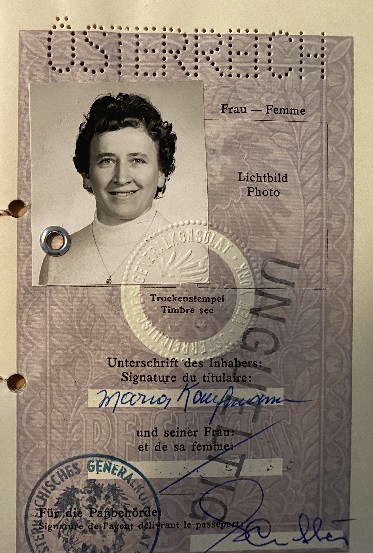 Mitzi
and son followed in late November, landing in Halifax and taking the train to Toronto. It was a "nice ship"
and life in Canada was "good." Mitzi
and son followed in late November, landing in Halifax and taking the train to Toronto. It was a "nice ship"
and life in Canada was "good."
Yet nine years later, in 1963, they would move on again, this time to New Jersey. There was an uncle there, and a friend,
and a job as a butcher, so they loaded up the car and made the trip.
When I asked how she liked New Jersey, her answer was, "Canada was nicer."
Regardless, they settled in and established what turned out to be permanent roots. A third child, Annie, joined brother Joe
and sister Rose. Over the years, grandchildren were born and the family built a house back in Strem; annual vacation trips
were made. But those trips ended ten years ago, when health problems interfered. Mitzi told me that, "when I'm better, we
will start going again." If she does go again, she'll have to do it without husband Frank, dead 20-plus years now, or
recently deceased son, Joe.

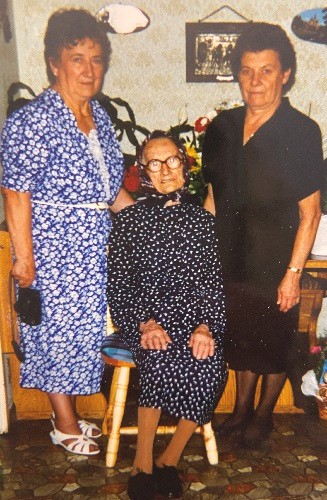 My
final question followed my spoken observation that it seemed clear that she still holds Burgenland dear, prompting me to
ask, "So, why didn't you move back?" My
final question followed my spoken observation that it seemed clear that she still holds Burgenland dear, prompting me to
ask, "So, why didn't you move back?"
The answer was slow in coming but was what I expected: "We have no one there now; everyone is dead... and I have children
and grandchildren here."
In those words, I felt the gentle melancholy that I think all of us in the later years of life feel... we made many choices
along the way: this man or woman; that job; this sequence of places to live... a whole series of decisions that led from
youth to old age; some carefully made, some flippantly made, some made out of necessity, but all decisions that
determined the course of our lives ...decisions impossible to unwind now. It may well be that we are not unhappy
about the choices we made... but, still, we wonder what life may have been like had we changed one or two of
those choices.
I think there was a lot said in the silence that prefaced so many of Mitzi's answers.
|
 Still
wearing my mask... hope you are too!
Still
wearing my mask... hope you are too!  Sarah's
younger sister Molly is in end stage renal failure and needs a new kidney; coping with this is also putting her in
financial distress. So Sarah is trying to do all she can to help Molly survive, even to the point of asking the BB community
for whatever help you can give. Why us? Because Molly is the youngest great-grandchild of John Kierein and Katherine
Ganzer from Pamhagen, Burgenland (they emigrated to South Bend, IN). So Molly is one of us.
Sarah's
younger sister Molly is in end stage renal failure and needs a new kidney; coping with this is also putting her in
financial distress. So Sarah is trying to do all she can to help Molly survive, even to the point of asking the BB community
for whatever help you can give. Why us? Because Molly is the youngest great-grandchild of John Kierein and Katherine
Ganzer from Pamhagen, Burgenland (they emigrated to South Bend, IN). So Molly is one of us.
 It is with much sadness we announce
the passing of our mother Mary Kirzinger of Powell River, Canada. Mary passed away peacefully at Powell River Evergreen Care
Unit at the age of 96 years.
It is with much sadness we announce
the passing of our mother Mary Kirzinger of Powell River, Canada. Mary passed away peacefully at Powell River Evergreen Care
Unit at the age of 96 years.  News
News
 The
Facebook Bunch (from Vanessa Sandhu):
The
Facebook Bunch (from Vanessa Sandhu): Update
for book "The Burgenländer Emigration to America": Here is this month's update on purchases of the English issue of
the 3rd edition of Dr. Walter Dujmovits' book "Die Amerika-Wanderung Der Burgenländer."
Update
for book "The Burgenländer Emigration to America": Here is this month's update on purchases of the English issue of
the 3rd edition of Dr. Walter Dujmovits' book "Die Amerika-Wanderung Der Burgenländer."

 Maria/Mitzi
(Domitrovits) Kaufmann was born in Strem in 1927 (making her 92 now) to parents Franz and Theresia (Hafner)
Domitrovits, originally of Strem and Glasing, respectively. Despite the Croatian roots of her father's surname, they
spoke German in the home. Her father had been in Pittsburgh in 1922-1925, came back to marry Theresia and, by the time Mitzi
was born, had already gone back to America. By 1929, her mother joined her father in America, but in Saddle River, NJ. Mitzi
says she was raised by her grandparents, presumably Ignatz and Cecelia (Garger) Domitrovits on the family farm in Strem, as
mother-in-law Cecelia is listed as Theresia's contact at home on her 1929 manifest and Mitzi says she was raised in Strem.
She also says she seldom saw her parents (they appear in the 1930 US census living in Manhattan, NY, but I can't find them
in the 1940 census). Mitzi had one brother, Johann, born in Strem in 1937, died there in 1992 (he married and had one
daughter, who also married and gave him a grandson).
Maria/Mitzi
(Domitrovits) Kaufmann was born in Strem in 1927 (making her 92 now) to parents Franz and Theresia (Hafner)
Domitrovits, originally of Strem and Glasing, respectively. Despite the Croatian roots of her father's surname, they
spoke German in the home. Her father had been in Pittsburgh in 1922-1925, came back to marry Theresia and, by the time Mitzi
was born, had already gone back to America. By 1929, her mother joined her father in America, but in Saddle River, NJ. Mitzi
says she was raised by her grandparents, presumably Ignatz and Cecelia (Garger) Domitrovits on the family farm in Strem, as
mother-in-law Cecelia is listed as Theresia's contact at home on her 1929 manifest and Mitzi says she was raised in Strem.
She also says she seldom saw her parents (they appear in the 1930 US census living in Manhattan, NY, but I can't find them
in the 1940 census). Mitzi had one brother, Johann, born in Strem in 1937, died there in 1992 (he married and had one
daughter, who also married and gave him a grandson). Hilda,
but I could not determine what happened with her.
Hilda,
but I could not determine what happened with her. When
asked by me what her earliest memories of life in Burgenland were, Mitzi initially hesitated... then answered with just a
few words: "It was a good life; I miss it."
When
asked by me what her earliest memories of life in Burgenland were, Mitzi initially hesitated... then answered with just a
few words: "It was a good life; I miss it." Mitzi
and son followed in late November, landing in Halifax and taking the train to Toronto. It was a "nice ship"
and life in Canada was "good."
Mitzi
and son followed in late November, landing in Halifax and taking the train to Toronto. It was a "nice ship"
and life in Canada was "good." My
final question followed my spoken observation that it seemed clear that she still holds Burgenland dear, prompting me to
ask, "So, why didn't you move back?"
My
final question followed my spoken observation that it seemed clear that she still holds Burgenland dear, prompting me to
ask, "So, why didn't you move back?"